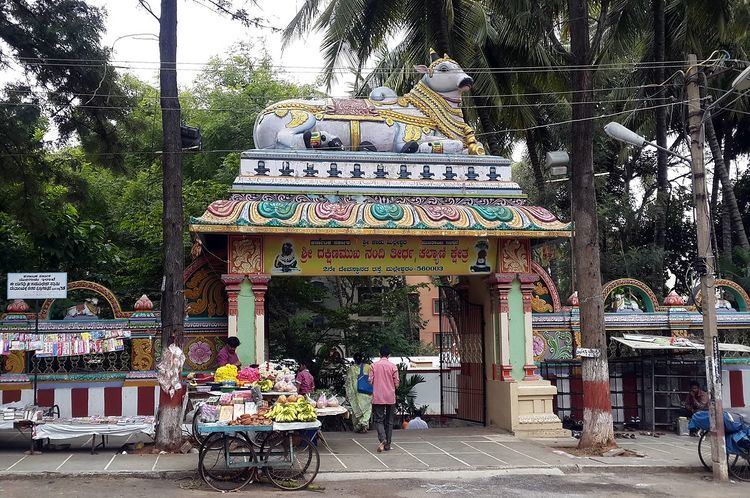Location Malleswaram | Primary deity Shivalinga (Shiva) District Bengaluru | |
 | ||
Similar Kadu Malleshwara Temple, Kolaramma Temple, Antara Gange, Gavi Gangadhareshwara Temple, Kote Venkataramana Temple | ||
Sri Dakshinamukha Nandi Tirtha Kalyani Kshetra is a small temple located in front of the Gangamma temple and diagonally opposite to the Kadu Malleshwara temple on 2nd Temple Street, Malleswaram layout in the north-western area of Bangalore city.
Contents
- Source of the name Dakshinamukha Nandi Tirtha Kalyani Kshetra
- Temple history
- Rediscovery of the temple
- Unique architecture of the temple
- Source of the water
- Other Shrines in the structure
- Rituals and Festivals
- References
The temple is also known as Nandi Tirtha, Nandishwara teertha, Basava teertha or simply as Malleswaram Nandi gudi.
The main deity of the temple is Shiva, in the form of a Shiva Linga (lingam).
Source of the name "Dakshinamukha Nandi Tirtha Kalyani Kshetra"
The focal point of this temple is a unique stone Nandi which is positioned facing the Southern direction – Dakshina in Kannada. ‘Dakhshinamuka Nandi’ means ‘South facing Nandi’.
There is a continuous stream of water that flows out of the Nandi’s mouth, which is considered to be holy water, referred to as ‘Tirtha’ in Kannada.
The water from the Nandi’s mouth falls onto the Shivalinga and flows into a stepped tank in the middle of the temple, called a ‘Kalyani’ - Temple tank in Kannada.
‘Kshetra’ means a ‘place’ in Kannada and is often used to refer to a place or region of historical or religious importance.
The combination of all the above elements adds up to the official name of the temple.
Temple history
There is no documented history available for the temple. Though it is mentioned as being up to 7000 years old, there is no historical evidence to substantiate the temple’s age.
There is a mention that while excavating the temple, the Archaeological Survey of India (ASI) estimated it to be around 400 years old, based on Carbon Dating.
Since the Nandi Tirtha temple is essentially a ‘Kalyani’ or a Stepped Temple tank usually built near big temples, this structure is considered to be part of the Kadu Malleswara Shiva temple complex.
Looking at the basic architectural design of the temple and the usage of rough-hewn stone pillars for the main structure, this temple can potentially pre-date the Kadu Malleswara temple. Similar rough stone pillars have been used in ancient temples such as the Chandira Choodeshwara Shiva temple at Hosur.
Rediscovery of the temple
At some point in its history, the Nandi Tirtha temple fell into disuse and was slowly buried under mud and dirt. As this temple is below the normal ground level of the surrounding area; and there is no Gopuram tower, the entire structure of this temple eventually disappeared from view.
However, knowledge of the existence of a Temple or Kalyani continued to survive in the memory of the people residing in this area.
As Malleswaram developed into one of the preferred residential areas of Bangalore, property prices increased significantly. In 1997, there was an attempt to usurp this temple area and sell it off as a vacant plot of land.
After protests by the local residents, the land in question was dug up and the temple complex gradually emerged from under the mud and dirt.
Unique architecture of the temple
The temple is essentially built as a pillared - covered corridor around a central stepped Temple tank or Kalyani.
The Nandi is considered to be Shiva’s vahana and usually placed in front, facing the Shivalinga in most temples. However, the Nandi in this temple is placed on a platform built above the Shivalinga.
A continuous stream of water flows out of the Nandi’s mouth and falls onto the Shivaling through an opening in the floor. The water then collects in the Kalyani and the over flow is evacuated into the open well outside the temple.
Source of the water
The source of the water flowing out of the Nandi’s mouth is not known. It can be a natural fresh water spring that emerges from under the temple and channeled to flow out through the Nandi.
Another view is that the water comes from the nearby Sankey Tank, which is located a few hundred meters away from the temple. Considering that the Sankey Tank was built in 1882; and the Nandi temple is significantly older, this view can be discounted.
Whatever the source of the water, this temple is an example of the ancient hydraulic engineering.
Other Shrines in the structure
There is a small shrine dedicated to Ganesha, located in the corridor towards the left of the Shivaling.
There is a Navagraha platform in the corridor towards the right side of main deity.
Rituals and Festivals
As a Shiva temple, all the traditional festivals and rituals associated with the main deity are organized and celebrated at this temple. Occasions like Maha Shivaratri see a huge crowd of devotees arriving for Darshan.
On regular days, the temple is open from 7:30 AM to 12 Noon and thereafter from 5:00 PM to 8:30 PM.
